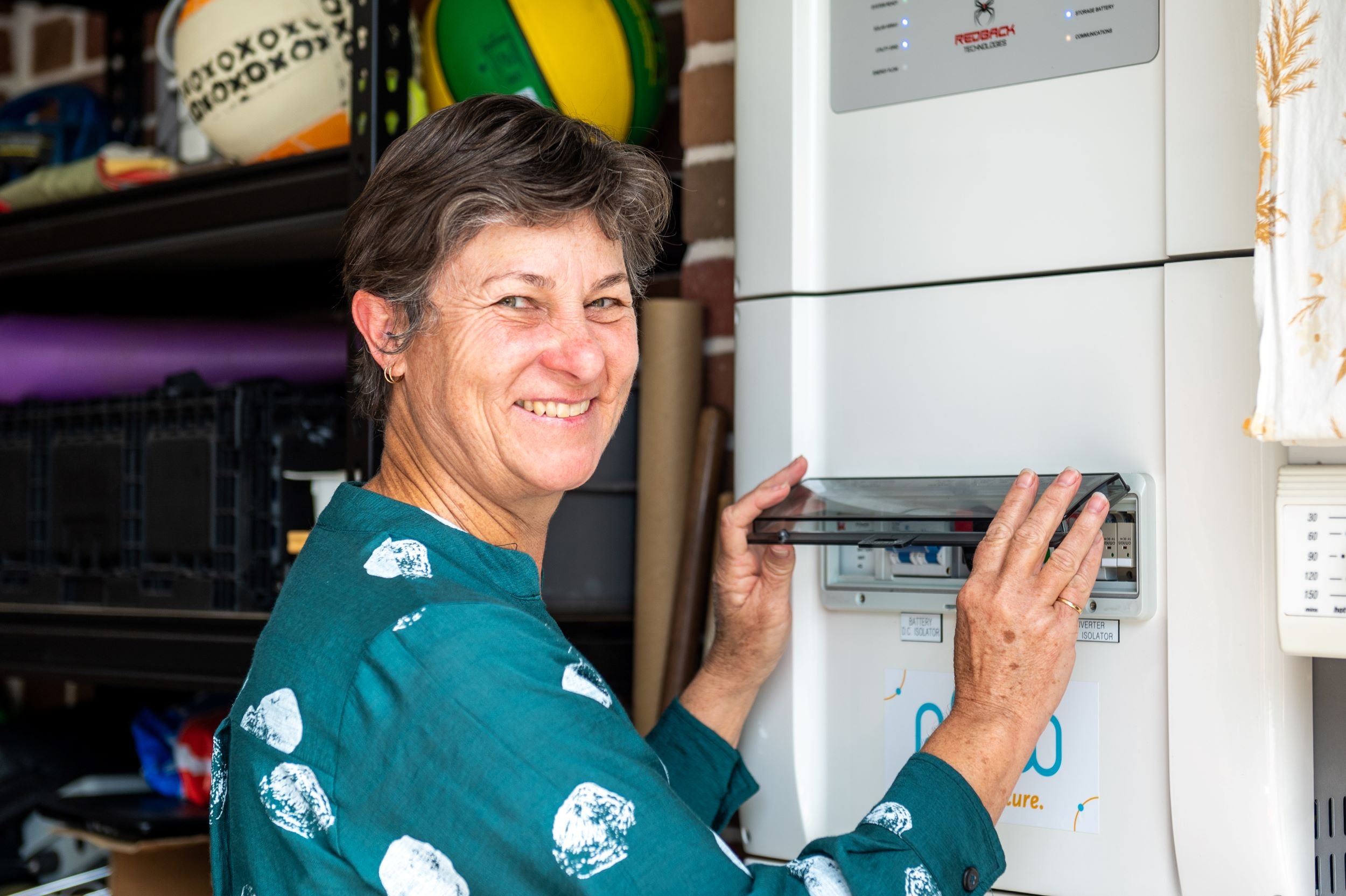Solar panels may not be charging your battery if your solar system isn’t generating enough power or because a technical fault has occurred. Faults with solar panels, batteries, inverters and wiring affect a solar panel’s ability to charge a battery. Checking your solar inverter is typically the best way to identify which component is faulty. Then, a qualified solar specialist can examine your system to identify and fix the issue.
How to check if your solar panel is charging your battery
Your system’s inverter is the easiest way to check if your solar panel is charging your battery. Depending on your system, you may need to inspect either a battery inverter or a hybrid inverter.
An inverter monitors the flow of electricity within your solar system and keeps track of your battery’s charge level. If your inverter is connected to an internet service, an app or desktop portal may help you identify what is happening with your battery with the use of an app or desktop portal. If you’ve confirmed that your battery’s charge level is not increasing, the next step is to identify the root cause of the issue.
To optimise your battery usage, check out our article on getting the most out of your solar battery.
Is your solar + battery system generating enough power?
It’s possible that your solar + battery system isn’t producing enough power to charge your battery. This is because solar panels prioritise supplying electricity to your home, and any excess power is then directed to the solar battery. However, if your solar panels can only generate enough energy to sustain your household’s needs, there won’t be any remaining to charge your battery.
There are two common explanations for underperforming solar + battery systems: insufficient capacity and system faults. If your solar + battery system has insufficient capacity, you may need to consider expanding it by adding more solar panels to generate enough power for your battery. On the other hand, if the issue is due to a fault in the system, you’ll need to identify the problem and have it fixed.
Do the parts of your solar + battery system match?
The compatibility of each solar + battery system component is essential for effective system function. For instance, a solar panel array generating 10 kW of power can’t operate at its maximum potential at any one time if paired with a 3 kVA inverter. The inverter’s capacity determines how much energy can be supplied to the household and battery. The size of the inverter should be matched with the energy needs of the household. A 5 kVA inverter is considered suitable for most households.
An undersized inverter could cause a bottleneck, with only limited generated power being distributed to the household, making it challenging to meet energy needs and charge the battery. Therefore, it’s crucial to ensure component compatibility before installation to maximise solar system performance.
How do you check if a solar panel is working?
The easiest way to see if a solar panel is working is to check your solar inverter. While solar panels generate electricity for your system, your inverter tracks it. So if your inverter indicates that power is not being generated, it’s likely that the panels are at fault.
There could be various reasons solar panels are failing to generate electricity, including hardware faults or environmental conditions that prevent them from effectively harnessing sunlight.
It’s important to note that in many solar systems, one underperforming panel could decrease the output of all other panels. This is particularly common in systems that use string inverters, which synchronise the capacity of all solar panels. If one panel is obstructed or damaged, it will bring down the output level of all other panels, hampering the system’s overall performance. This is the primary reason Plico opts not to use string inverters in our solar + battery systems.
Hardware problems
Hardware issues in solar panels can arise due to physical damage, such as when the panels are struck by falling debris. However, other problems can be more subtle, such as the development of microcracks. These tiny fissures can be hard to detect initially but can worsen over time and cause significant damage. Microcracks can be caused by various factors, such as excessive heat, cold, humidity, wind, or manufacturing defects. Moisture can enter the solar panel cells through these microcracks and gradually decrease their output, reducing efficiency over time.
Access to sunlight
Exposure to adequate sunlight is essential for optimal solar panel performance. Even though solar panels can generate electricity without direct sunlight, their capacity decreases. In general, more sunlight means more power. However, cloudy weather and shorter daylight hours reduce the amount of sunlight that reaches the panels, which is why solar generation tends to decrease during the winter months. Although you can’t control the weather, you can increase the energy capture when the sun’s out by adding more solar panels to your system.
There are also other factors related to sunlight capture that you can control. Dirt buildup on solar panels can negatively affect performance, so regular cleaning may be required, especially if you live near the coast or in areas with construction. Shade blocks sunlight from reaching solar panels, so it is best to place panels in non-shaded areas and eliminate sources of shade, such as tree branches. Proper panel orientation is also critical for optimal sunlight gathering; panels should be mounted on stands for houses with flat roofs to ensure they are angled appropriately.
For more information on the factors that may cause solar panel deterioration over time, check out Plico’s blog on the lifespan of solar panels in Australia.

How do I know if my solar battery is working?
To check the functionality of your solar battery, refer to your inverter - this may be a battery inverter or a hybrid inverter depending on the solar setup. The inverter displays information about the charging and discharging of the solar battery, including whether it provides electricity to the home. For example, if your household uses grid power at night when there is capacity available in your battery, this may be a sign that your battery is not discharging properly.
It’s important to note that different types and models of solar batteries have varying requirements for optimal function. So be sure to familiarise yourself with the specific needs of your solar battery to ensure it charges and operates as intended.
How do you know if the solar inverter is working?
The best way to check if your solar inverter is working is by examining it directly. Since the inverter manages the flow of electricity within a solar system, a faulty inverter may inhibit the flow from the solar panels to the battery. This could prevent the battery from receiving charge and potentially drain its power. In addition, solar inverters display system errors differently depending on the model. This may be anything from a red flashing light to an error message. The solar inverter’s manual will clarify this.
While power generation varies depending on factors like the time of year, significant discrepancies may indicate an issue with the inverter. Compare the kWh of solar exports tallied on your inverter with your power bills to ensure they align. If the inverter indicates that no power is being generated, yet your power bills show that your grid consumption is low and you are exporting solar back to the grid, the inverter is likely malfunctioning.
If you notice some of these issues and suspect there is a problem with your inverter, contact your solar system installer.
How do I know if my solar system has wiring problems?
If you have examined all of your solar systems components for faults and found none, there may be problems with your system’s wiring. The entire solar system is connected with wires, including the solar panels and battery. If wiring is damaged, it may affect both a solar panel’s power generation and a solar battery’s ability to receive power. Wiring faults may be due to improper installation or damage or degradation to the wires over time. You may be able to spot some wiring faults, but enlisting an electrician or solar system installer to have a look is the safest option.
If you have examined all of your solar systems components for faults and found none, there may be problems with your system’s wiring. The entire solar system is connected with wires, including the solar panels and battery.
If wiring is damaged, it may affect both a solar panel’s power generation and a solar battery’s ability to receive power. Wiring faults may be due to improper installation or damage or degradation to the wires over time.
If you suspect you have wiring faults, enlist an electrician or solar system installer to have a look. This is the safest option.
How to repair solar system faults
Hiring a licensed installer is the best way to repair solar system faults. Attempting to repair your solar system is dangerous and risks potentially damaging your system further. An expert is able to diagnose the issue and inform you of the necessary next step, no matter which component is malfunctioning.
If your solar system is still under warranty, the repair and replacement costs may be covered. It is important to check your warranty details to ensure that you are aware of the terms and conditions regarding any repairs or replacements.
As a rule of thumb, relying on a professional to repair any faults in your solar system is always better than attempting to fix it yourself.
Plico members receive 10 years of ongoing support
Becoming a Plico member is different to just buying a solar + battery system. Yes, there’s the one low weekly instalment, but there’s also the security of 10 years of ongoing support from our team of experts. We ensure that our members are getting the best from their solar + battery systems.
We monitor all our members’ systems remotely so we can proactively address any potential issues. This ensures our systems run optimally at all times and our members get the most savings on their power bills. If anything needs repairs or replacement, we arrange all this for you so you don’t have to go it alone with the manufacturer.
Contact one of the switched-on Plico team members to find out if a solar + battery system is right for you.
Have a question about solar + battery?

